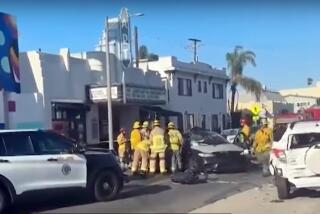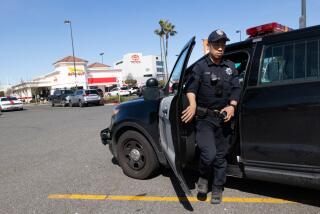Sometimes Itâs Give Up Rather Than Give Chase : Pursuit: Policy opts for caution over putting innocent people in the path of danger, meaning fleeing suspects arenât always caught.
People who think cops get high on the smell of burning rubber would have been shocked by the scene unfolding one morning in the Van Nuys watch commanderâs office.
An assault suspect is fleeing in a car down Ventura Boulevard with several black-and-whites in pursuit.
Lt. Stan Embry, the man in charge, is beginning to worry. Not that they might lose him.
An assistant announces that the LAPD helicopter is now overhead. âAll units back off,â Embry orders.
The suspect stops in the middle of the street and looks around, wondering what happened to the cops.
A good question. For nowhere does the faceoff between the new, smarter and more cautious LAPD and the old guard of crime-busters show itself more clearly than in the departmentâs pursuit policy.
In the old days, you didnât run from the LAPD. Or if you did, you better be ready for a thumping when you were caught.
Los Angeles, like other big cities with pockets deep enough to tempt personal injury attorneys, has rethought its position on chasing criminals. The policy now balances the risks of chasing suspects through L. A.âs clogged arteries against the danger to the public and the severity of the crime. These days, they are even willing to let the bad guys win one once in a while.
âYou have to weigh the dangers,â Embry says. âSeveral things can happen at the end of the pursuit,â and most of them are bad. âThe suspect crashes, or the officer crashes, or the suspect gives up.
âIf my family is driving down the street and thereâs a chase and they crash into my car, injuring my wife and kids, I want somebody to pay,â Embry says. âI donât care how bad this bad guy was.â
The policy is not popular with a lot of officers, who say it sends a terrible message to the lawbreakers. âThe law works with two factors: [punishment that is] swift and sure,â says Ken Belt, a detective with the anti-auto theft unit in Van Nuys, which has an impressive record tracking down stolen cars.
âIf you donât bring those to bear, it makes a mockeryâ of the law, he said, âbecause the thief thinks heâs got the advantage.â
Because car theft is no longer considered a serious crime, Belt will break off his pursuit as soon as the thief starts driving erratically or âbusting lights.â
Embry doesnât care whether the policy makes street cops grumble. âIt saves their lives and keeps them from getting hurt,â he says. The suspects have âall committed crimes before. If we donât catch them this time, we will next time.â
Todayâs pursuit involves a serious crime, and so they keep at it. But even then, as soon as the helicopter is in place, the police cars pull off, leaving it to the eye in the sky to track the suspectâs progress.
âThis guy can ride around all over the city and the airship can stay right above,â Embry says confidently. Eventually, the driver will get tired and give up.
But what if the suspect gets away by driving through an area with a lot of trees, blocking the helicopterâs view?
âI donât care about losing him,â Embry snaps. âIâm more concerned about citizens driving down the street.â
That rarely happens with the helicopter, anyway. And the decision to call off the black-and-whites looks good when the speeding van slows as the suspect tries to figure out whatâs going on.
Sgt. Joe Brazas, his ear to a hand-held radio, feeds frequent reports to Embry. The crime is not just an assault, he says now, but a carjacking. The female victim was run over when her attacker sped off in her van.
âSheâs in emergency treatment,â Brazas says. âThis is a verified felony.â
The stakes are raised. Officers coming off morning watch wander in to listen. Russ Carr, a respected veteran who candidly admits he liked it better when the department did things the military way, flips on an old black-and-white television.
Television loves car chases, and Carr has his choice of channels. âIt looks like the police have decided to let him drive until he stops,â says one television reporter. âThe police know exactly what theyâre doing.â
âThatâs nice,â says Embry.
âHe didnât say they agreed with it,â Carr says, settling into a ragged chair in full uniform to watch the drama play out.
Brazas issues another update that ratchets up the importance of the crime one more notch. âThe suspect forced open the door, beat her around the head, threw her on the ground and left.â
The van changes direction and heads into the parking lot at Valley College.
The lot is sealed off, and the van turns onto the campus grounds and speeds down a concrete walkway, smashing into a trash can and sending litter flying. The suspect spins out before regaining control. Brazas reports that students are throwing rocks and bottles at the van. The atmosphere in the watch commanderâs office grows more tense. The police wonât look so good if the suspect runs down a student.
The suspect drives over a curb leaving campus and then, suddenly, gives up. He gets out of the van and lies on the pavement as police cars reappear from all sides.
The television news breaks away and a contented smile crosses Embryâs face. âIt went exactly the way I wanted it to,â he says.
Chalk one up for smart and cautious.
More to Read
Sign up for Essential California
The most important California stories and recommendations in your inbox every morning.
You may occasionally receive promotional content from the Los Angeles Times.










